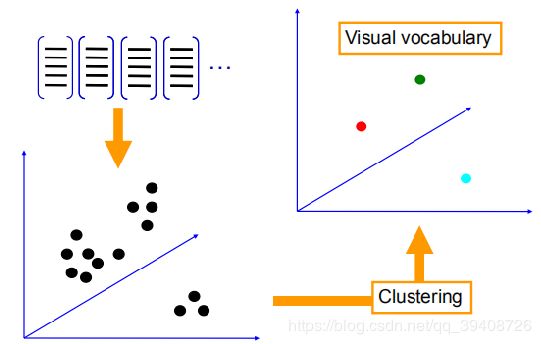图像特征词典原理及实现
图像特征词典原理及实现
原理
一.Bag of features: 基础流程
聚类是实现 visual vocabulary /codebook的关
键
• 无监督学习策略
• k-means 算法获取的聚类中心作为 codevector
• Codebook 可以通过不同的训练集协同训练获得
• 一旦训练集准备足够充分, 训练出来的码本( codebook)将
具有普适性
码本/字典用于对输入图片的特征集进行量化
• 对于输入特征,量化的过程是将该特征映射到距离其最接近
的 codevector ,并实现计数
• 码本 = 视觉词典
• Codevector = 视觉单词

4.把输入图像转化成视觉单词(visual words)
的频率直方图
5.构造特征到图像的倒排表,通过倒排表快速索引相关图像
给定图像的bag-of-features直方图特征,如何
实现图像分类/检索?

给定输入图像的BOW直方图, 在数据库中查找 k 个最近邻
的图像
对于图像分类问题,可以根据这k个近邻图像的分类标签,
投票获得分类结果
当训练数据足以表述所有图像的时候,检索/分类效果良
好
6.根据索引结果进行直方图匹配
代码及实现
1.生成词典
.`# -- coding: utf-8 --
import pickle
from PCV.imagesearch import vocabulary
from PCV.tools.imtools import get_imlist
from PCV.localdescriptors import sift
##要记得将PCV放置在对应的路径下
#获取图像列表
imlist = get_imlist(‘D:/Visual_Studio_Code/data/first1000/’) ###要记得改成自己的路径
nbr_images = len(imlist)
#获取特征列表
featlist = [imlist[i][:-3]+‘sift’ for i in range(nbr_images)]
#提取文件夹下图像的sift特征
for i in range(nbr_images):
sift.process_image(imlist[i], featlist[i])
#生成词汇
voc = vocabulary.Vocabulary(‘ukbenchtest’)
voc.train(featlist, 1000, 10)
#保存词汇
#saving vocabulary
with open(r’D:\Visual_Studio_Code\data\first1000\vocabulary.pkl’, ‘wb’) as f:
pickle.dump(voc, f)
print (‘vocabulary is:’, voc.name, voc.nbr_words)
2把数据导入数据库
# -*- coding: utf-8 -*-
import pickle
from PCV.imagesearch import imagesearch
from PCV.localdescriptors import sift
from sqlite3 import dbapi2 as sqlite
from PCV.tools.imtools import get_imlist
##要记得将PCV放置在对应的路径下
#获取图像列表
imlist = get_imlist('D:/Visual_Studio_Code/data/first1000/')##记得改成自己的路径
nbr_images = len(imlist)
#获取特征列表
featlist = [imlist[i][:-3]+'sift' for i in range(nbr_images)]
# load vocabulary
#载入词汇
with open(r'D:\Visual_Studio_Code\data\first1000\vocabulary.pkl', 'rb') as f:
voc = pickle.load(f)
#创建索引
indx = imagesearch.Indexer('testImaAdd.db',voc)
indx.create_tables()
# go through all images, project features on vocabulary and insert
#遍历所有的图像,并将它们的特征投影到词汇上
for i in range(nbr_images)[:1000]:
locs,descr = sift.read_features_from_file(featlist[i])
indx.add_to_index(imlist[i],descr)
# commit to database
#提交到数据库
indx.db_commit()
con = sqlite.connect('testImaAdd.db')
print (con.execute('select count (filename) from imlist').fetchone())
print (con.execute('select * from imlist').fetchone())
3。实现
.`# -- coding: utf-8 --
import pickle
from PCV.localdescriptors import sift
from PCV.imagesearch import imagesearch
from PCV.geometry import homography
from PCV.tools.imtools import get_imlist
load image list and vocabulary
#载入图像列表
imlist = get_imlist(‘first1000/’)
nbr_images = len(imlist)
#载入特征列表
featlist = [imlist[i][:-3]+‘sift’ for i in range(nbr_images)]
#载入词汇
with open(‘first1000/vocabulary.pkl’, ‘rb’) as f:
voc = pickle.load(f)
src = imagesearch.Searcher(‘testImaAdd.db’,voc)
#index of query image and number of results to return
#查询图像索引和查询返回的图像数
q_ind = 0
nbr_results = 20
regular query
#常规查询(按欧式距离对结果排序)
res_reg = [w[1] for w in src.query(imlist[q_ind])[:nbr_results]]
print (‘top matches (regular):’, res_reg)
#load image features for query image
#载入查询图像特征
q_locs,q_descr = sift.read_features_from_file(featlist[q_ind])
fp = homography.make_homog(q_locs[:,:2].T)
#RANSAC model for homography fitting
#用单应性进行拟合建立RANSAC模型
model = homography.RansacModel()
rank = {}
load image features for result
#载入候选图像的特征
for ndx in res_reg[1:]:
locs,descr = sift.read_features_from_file(featlist[ndx]) # because ‘ndx’ is a rowid of the DB that starts at 1
# get matches
matches = sift.match(q_descr,descr)
ind = matches.nonzero()[0]
ind2 = matches[ind]
tp = homography.make_homog(locs[:,:2].T)
# compute homography, count inliers. if not enough matches return empty list
try:
H,inliers = homography.H_from_ransac(fp[:,ind],tp[:,ind2],model,match_theshold=4)
except:
inliers = []
# store inlier count
rank[ndx] = len(inliers)
#sort dictionary to get the most inliers first
sorted_rank = sorted(rank.items(), key=lambda t: t[1], reverse=True)
res_geom = [res_reg[0]]+[s[0] for s in sorted_rank]
print (‘top matches (homography):’, res_geom)
#显示查询结果
imagesearch.plot_results(src,res_reg[:8]) #常规查询
imagesearch.plot_results(src,res_geom[:8]) #重排后的结果






